Jefferson Portrait by John Trumbull (Painting)
John Trumbull began to work on his masterpiece, The Declaration of Independence, July 4, 1776, while he stayed with Jefferson at the Hôtel de Langeac in Paris between December 1787 and February 1788, when he returned to London.[1] Jefferson described the scene in the Assembly Room at Independence Hall in great detail—including the exact placement of the representatives to the Continental Congress—and sketched the room for Trumbull. Trumbull planned to obtain life portraits of all the living representatives, and made Jefferson his first subject.
On December 19, 1788, Trumbull presented Jefferson with "a little case with two pictures, one of which I hope you will do me the honor to accept, and the other I beg you to be so good as offer to Miss Jefferson."[2] The gift for Jefferson was a miniature of Thomas Paine and the second was a miniature of Jefferson for his daughter Martha. Trumbull made three different miniatures of Jefferson derived from the life portrait in the Declaration of Independence. In the Declaration Jefferson is seen as he would have looked in 1776 with unpowdered reddish hair and wearing clothes then fashionable. On the other hand in the three miniatures, each distinct from the others, Jefferson is depicted more formally with rolled and powdered hair, waistcoat, and jabot.
William Short, Jefferson's secretary, knew that he had painted miniatures for Jefferson's friends Maria Cosway and Angelica Schuyler Church, and encouraged Trumbull to paint a third. He asked Trumbull:
Shall I put you in a way to do a very clever gallant thing? You have not time to think of people so far off and therefore you will excuse my giving you the hint—make what you please of it. Send a copy of the same to Miss Jefferson. Dont say that the hint came from me or from any body.[3]
Jefferson reported that Martha was delighted to have the portrait of her father:
I am to thank you a thousand times for the portrait of Mr. Paine, which is a perfect likeness, and to deliver you, for the other, on the part of my daughter, as many more as the sensations of the young are more lively than of the old.[4]
- Text from Stein, Worlds, 124
References
- ^ For a full account of this painting, see Irma B. Jaffe, Trumbull: The Declaration of Independence (New York: Viking Press), 1976.
- ^ Trumbull to Jefferson, December 19, 1788, in PTJ, 14:364. Transcription available at Founders Online.
- ^ Short to Trumbull, September 10, 1788, quoted in PTJ, 14:365n. Editorial note available at Founders Online. The miniature belonging to Mrs. Church is now in the collection of the Metropolitan Museum of Art, New York, and the portrait owned by Mrs. Cosway is in the collection of the Collegio delle Grazie di Maria SS. Bambina in Lodi, Italy. For more information on it, consult Elizabeth Cometti, "Maria Cosway's Rediscovered Miniature of Jefferson," William and Mary Quarterly, 3rd ser., vol. 9, no. 2 (April 1952): 152-55.
- ^ Jefferson to Trumbull, January 12, 1789, in PTJ, 14:440. Transcription available at Founders Online.

